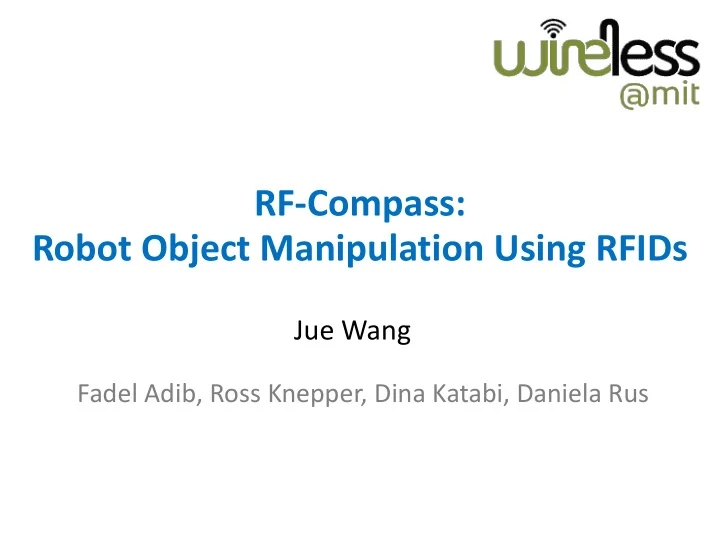

RF-Compass: Robot Object Manipulation Using RFIDs Jue Wang Fadel Adib, Ross Knepper, Dina Katabi, Daniela Rus
Limitation of Today’s Robotic Automation Fixed-position, single-task robot • Limited to large-volume production line • Inability to change manufacturing process
Toyota has been slowly backing away from heavy automation. The labor saved by robots was wasted most of all by reprogramming robots . The potential for much broader industrial acceptance is tied to the development of robots that can absorb data, recognize objects, and respond to information and objects in their environment with greater accuracy . This is the future . A new wave of robots, far more adept than those now commonly used by automakers and other heavy manufacturers.
Mobile Manipulation Fetching, grasping, and manipulating objects • Extend automation to small/medium factories • Easy to reconfigure manufacturing process
Requirements for Mobile Manipulation • Centimeter-scale localization, e.g., 2cm • Minimal instrumentation portable
Current Approaches • Motion capture system, e.g., VICON – Sub-centimeter accuracy – Heavy instrumentation & Expensive
Current Approaches • Motion capture system, e.g., VICON – Sub-centimeter accuracy – Heavy instrumentation & Expensive • Imaging (e.g., optical camera, Kinect, LIDAR) – Needs prior training or ?
Current Approaches • Motion capture system, e.g., VICON – Sub-centimeter accuracy – Heavy instrumentation & Expensive • Imaging (e.g., optical camera, Kinect, LIDAR) – Needs prior training or ?
Can RF localization help?
Current RF localization schemes are too coarse • State-of-the-art WiFi localization: 23cm [ ArrayTrack ] • State-of-the-art RFID localization: 11cm [ PinIt ] BUT requires a dense grid of reference tags How to get a few cm accuracy without environment instrumentation?
RF-Compass • Place RFID tags on both robot and objects • No reference tags in the environment
Identifying the Object • RFID: a passive sticker – no battery, low cost • Reader shines RF signal on tags Each tag replies with its unique ID Works for up to 10 meters
How to get centimeter-scale accuracy?
Building block: RF pairwise comparison • Compare distances between RFIDs Tag 3 Tag 2 Tag 1 Which blue tag is closer to the red tag? Distance ordering based on signal similarity [SIGCOMM’13]
Basic building block 2cm accuracy
Basic Idea: Localization by Partitioning Is the red tag closer to Tag 1 or Tag 2?
Basic Idea: Localization by Partitioning Tag 1 is closer than Tag 2
Basic Idea: Localization by Partitioning Tag 3 is closer than Tag 4
Basic Idea: Localization by Partitioning Tag 4 is closer than Tag 1
Basic Idea: Localization by Partitioning But not yet centimeter accuracy
Basic Idea: Localization by Partitioning • Partitions can be iteratively refined
Iterative Refining via Robot Navigation • Leveraging robot’s consecutive moves
Iterative Refining via Robot Navigation • Every robot move gives a new set of partitions
Iterative Refining via Robot Navigation • Lay new partitions over old partitions to refine
Iterative Refining via Robot Navigation • Keep refining until reaching centimeter accuracy
Iterative Refining via Robot Navigation • Keep refining until reaching centimeter accuracy
Formulation as an Optimization 𝑦 0 2 + 𝑧 2 2 − 𝑦 1 2 − 𝑧 1 2 2 𝑦 2 − 𝑦 1 2 𝑧 2 − 𝑧 1 𝑧 0 ≤ 𝑦 2 (𝑦 0 , 𝑧 0 ) (𝑦 1 , 𝑧 1 ) (𝑦 2 , 𝑧 2 )
Formulation as an Optimization 2 + 𝑧 2 2 − 𝑦 1 2 − 𝑧 1 𝑦 0 2 2(𝑦 2 − 𝑦 1 ) 2(𝑧 2 − 𝑧 1 ) 𝑧 0 ≤ 𝑦 2 ⋮ ⋮ ⋮ (𝑦 0 , 𝑧 0 )
Formulation as an Optimization 𝑩 𝑦 0 • A feasibility problem with 𝑧 0 ≤ 𝒄 linear constraints • Efficiently solved via convex optimization (𝑦 0 , 𝑧 0 ) • Over-constrained system ↓ Robustness to errors & outliers Works correctly even if randomly flipping 10% of pairwise comparisons, shown in paper
Orientation Problem: also need orientation for grasping Solution: • Multiple RFIDs on object • Naïve approach: localize each RFID independently and find orientation • Our approach: joint optimization using knowledge of their relative location
Evaluation • Used a robot to fetch IKEA furniture parts • 9 tags on robot, 1 – 4 tags on object
Baseline • VICON motion capture system • Sub-centimeter accuracy • Infrared cameras + infrared-reflective markers VICON Markers
Navigation Performance Direct line-of-sight Occlusion and NLOS VICON does NOT work in NLOS Only 6% longer than CDF CDF optimal on average Ratio to Optimal Path in LOS Ratio to Optimal Path in NLOS RF-Compass enables effective navigation in NLOS
Center Position Accuracy Error in Position Estimate (cm) 6 5 4 cm 4 2.8 cm 3 1.9 cm 2 1.3 cm 1 0 1 Tag 2 Tags 3 Tags 4 Tags Number of Tags on Furniture Part
Orientation Accuracy Error in Orientation (degree) 7 5.8 ˚ 6 5 3.6 ˚ 4 3.3 ˚ 3 2 1 0 2 Tags 3 Tags 4 Tags Number of Tags on Furniture Part
Conclusion • RF-Compass: accuracy of a few cm and degrees • Iterative refining by leveraging robot’s navigation • Opens up opportunities for bridging robot object manipulation with RF localization
Recommend
More recommend